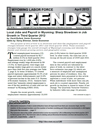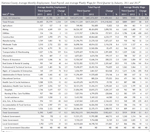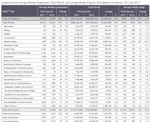Local Jobs and Payroll in Wyoming: Sharp Slowdown
in Job Growth in Third Quarter 2012
The purpose of this article is to illustrate and describe employment and payroll changes between third quarter 2011 and third quarter 2012. These economic changes help gauge the overall strength of Wyoming's economy and identify the fastest and slowest growing sectors and geographic areas.
Total unemployment insurance (UI) covered payroll increased by $2.7 million (0.1%) in third quarter 2012. Employment rose by 1,649 jobs (0.6%) and average weekly wage decreased by $4 (-0.5%). In third quarter, total wages and average weekly wage grew at a much slower pace than their five year averages (see Table 1). In terms of dollars, UI covered payroll represents approximately 91.5% of all wage and salary disbursements and 43.8% of personal income in the state (U.S. Bureau of Economic Analysis, 2013). Analysts have noted that "minerals related employment is one of the key predictors of sales and use tax revenue" in Wyoming (CREG 2010).
Despite the recent growth, overall employment remains approximately 10,000 jobs (3.4%) below its third quarter 2008 level. In other words, the state has yet to recoup all the job losses of 2009 and 2010.
The covered payroll and employment data in this article are tabulated by place of work, in contrast to the labor force estimates which are a measure of employed and unemployed persons by place of residence. Also, the employment data presented in this article represent a count of jobs, not persons. When individuals work more than one job, each job is counted separately. Finally, job growth (or decline) is stated in terms of net change. The Quarterly Turnover Statistics by Industry table presents alternative measures of job gains and losses using the same data sources and calculated to describe the components of change.
Figure 1 shows Wyoming wage & salary employment by covered/non-covered status. Approximately 92% of wage & salary jobs in the state are covered by state unemployment insurance, while 2.6% of jobs are covered by federal unemployment insurance, and 0.9% are covered by unemployment insurance administered by the railroad retirement board. There are several categories of non-covered jobs, and together they account for approximately 5% of wage & salary jobs in the state. Some examples of non-covered employment include elected officials, students working at educational institutions, employees of churches, and workers at small non-profit organizations.
Job growth slowed sharply from 2.2% in second quarter 2012 to 0.6% in third quarter 2012 (see Table 2). Total payroll growth also fell dramatically in third quarter, decreasing from 4.8% to 0.1% (see Figure 2).
Employment and Wages by County
Employment increased in 13 counties and decreased in 10 counties (see Table 3). Total payroll rose in 10 counties and fell in 13 counties.
Converse County added 302 jobs (5.5%) and its total payroll rose by $4.3 million (7.1%). The largest job gains occurred in mining (including oil & gas), accommodation & food services, and construction.
Employment grew by 283 jobs (1.0%) in Campbell County but its total payroll fell by $8.5 million (-2.3%). Local government (including public schools, colleges, & hospitals) added more than 200 jobs. Smaller job gains were seen in accommodation & food services, utilities, and retail trade. Total payroll decreased in mining (-$5.3 million) and construction (-$1.3 million).
Park County gained 268 jobs (1.7%) but its total payroll fell by $1.3 million (-1.0%). Modest job gains were seen in many sectors, such as local government, federal government, information, health care & social assistance, and transportation & warehousing.
Carbon County added 248 jobs (3.6%) and its total payroll rose by $5.5 million (8.3%). The construction sector grew by more than 200 jobs.
Teton County gained 173 jobs (0.9%) and its total payroll increased by $3.2 million (1.7%). Growth was seen in a number of sectors, such as accommodation & food services, professional & technical services, health care & social assistance, and transportation & warehousing. Job losses were seen in private educational services, construction, and manufacturing.
Sublette County lost 865 jobs (-13.8%) and its total payroll fell by $20.4 million (-22.1%). Mining (including oil & gas) lost nearly 500 jobs, construction lost approximately 250 jobs, and transportation & warehousing lost approximately 100 jobs. Mining payrolls fell by $10.7 million and construction payrolls fell by $6.9 million.
Employment fell by 449 jobs (-7.3%) and total payroll fell by $7.4 million (-11.6%) in Lincoln County. Job losses were seen in many sectors, including construction, mining, accommodation & food services, professional & technical services, and transportation & warehousing.
Platte County lost 171 jobs (-5.0%) and total payroll fell by $2.3 million (-7.3%). Employment fell in several sectors, including accommodation & food services, agriculture, and local government.
Employment decreased by 105 jobs (-0.7%) and total payroll decreased by $3.0 million (-2.1%) in Albany County. Job losses were seen in construction, administrative & waste services, health care & social assistance, and private educational services. Employment grew in accommodation & food services and local government.
Big Horn County lost 105 jobs (-2.4%) and its total payroll fell by $1.0 million (-2.4%). Employment fell modestly in construction, health care & social assistance, mining, and wholesale trade.
Sweetwater County lost 103 jobs (-0.4%) and its total payroll fell by $2.5 million (-0.7%). Employment fell in administrative & waste services, other services, construction, professional & technical services, and finance & insurance. Job gains were seen in accommodation & food services, health care & social assistance, and wholesale trade.
Natrona County added 1,351 jobs (3.4%) and its total payroll grew by $19.4 million (4.2%). Large job gains were seen in construction (271 jobs, or 9.6%), wholesale trade (222 jobs, or 8.8%), other services (187 jobs, or 9.7%), and accommodation & food services (171 jobs, or 4.6%). Employment fell in hospitals (-127 jobs, or -7.3%) and arts, entertainment, & recreation (-83 jobs, or -14.0%).
Laramie County gained 423 jobs (1.0%), but its total payroll decreased by $2.1 million (-0.5%). Job growth was seen in other services (160 jobs, or 12.9%), wholesale trade (105 jobs, or 12.8%), and construction (87 jobs, or 2.9%). A number of sectors were affected by job losses, including manufacturing (-146 jobs, or -9.8%), federal government (-128 jobs, or -4.8%), and professional & technical services (-36 jobs, or -2.4%).
Employment & Wages by Industry
When viewed from an industry perspective, the largest job gains occurred in local government (including public schools, colleges, & hospitals), accommodation & food services, wholesale trade, and other services (see Table 4). Employment fell in mining (including oil & gas), administrative & waste services, and private hospitals.
Local government added 805 jobs (2.0%) and its total payroll grew by $7.5 million (1.9%). Hospitals gained 301 jobs (4.5%) and local government education (including public schools & colleges) gained 222 jobs (1.3%). Public administration (including cities, towns, & counties) grew by approximately 150 jobs.
Accommodation & food services gained 546 jobs (1.6%) and its total payroll increased by $4.6 million (2.9%). Food services & drinking places added approximately 550 jobs, while employment edged down slightly in accommodation.
Employment in wholesale trade grew by 272 jobs (3.1%) and its total payroll rose by $3.0 million (2.4%). Merchant wholesalers of durable goods added more than 150 jobs, while electronic markets & agents & brokers added approximately 100 jobs.
Other services grew by 212 jobs (2.5%) and its total payroll increased by $3.7 million (5.0%). Repair & maintenance services added nearly 200 jobs.
Mining (including oil & gas) lost 461 jobs (-1.6%) and its total payroll fell by $10.1 million (-1.8%). Third quarter is the first time employment has decreased in this sector since 2010. Support activities for mining (which includes oil & gas well drilling) lost nearly 700 jobs. Employment increased in oil & gas extraction and mining, except oil & gas. Job losses in oil & gas drilling may be associated with low natural gas prices.
Employment in administrative & waste services fell by 357 jobs (-4.0%) and its total payroll decreased by $1.2 million (-1.9%). Employment services (including temporary help agencies) lost more than 300 jobs, and other support services lost more than 100 jobs. Modest job gains occurred in facilities support services and waste management & remediation services.
Private hospitals shed 198 jobs (-6.0%) and total payroll fell by $3.3 million (-8.0%). It is possible that in an effort to cut costs, hospitals may have outsourced certain functions to outside contractors.
In summary, job growth slowed sharply in third quarter because of large job losses in oil & gas. For approximately two years, mining (including oil & gas) was a key contributor to overall job growth, but in third quarter, it reversed course and lost jobs. Total payroll was practically unchanged from a year earlier and average weekly wage decreased slightly, suggesting overall weakness in the state's economy.
References
Consensus Revenue Estimating Group (CREG) (2010, October) Wyoming state government revenue forecast fiscal year 2011-fiscal year 2016. Retrieved February 17, 2011 from http://eadiv.state.wy.us/creg/GreenCREG_Oct10.pdf
U.S. Bureau of Economic Analysis. (2013, January 16). SA04 State income and employment summary. Retrieved January 16, 2013, from http://www.bea.gov/iTable/iTable.cfm?ReqID=70&step=1&isuri=1&acrdn=4








